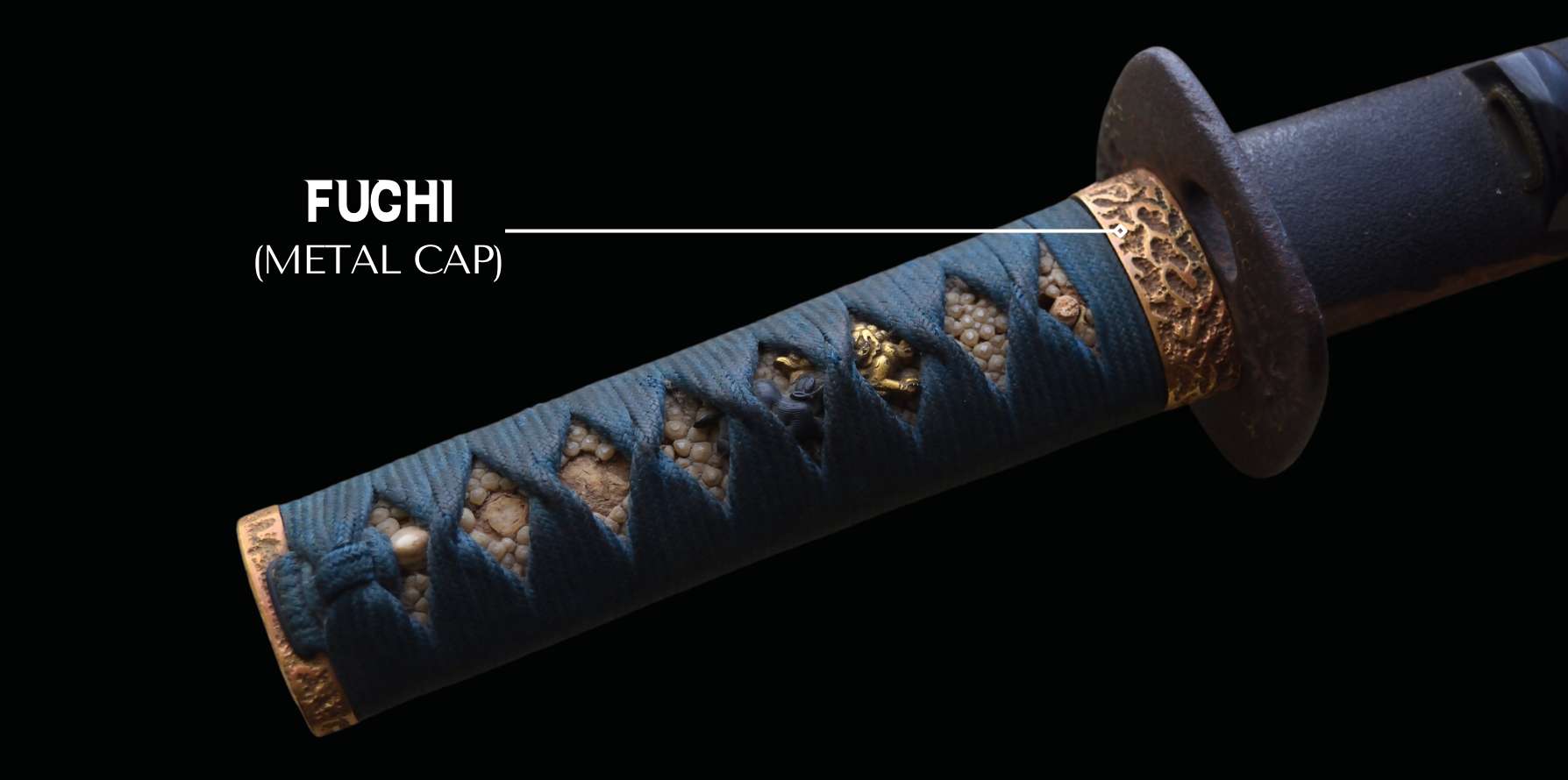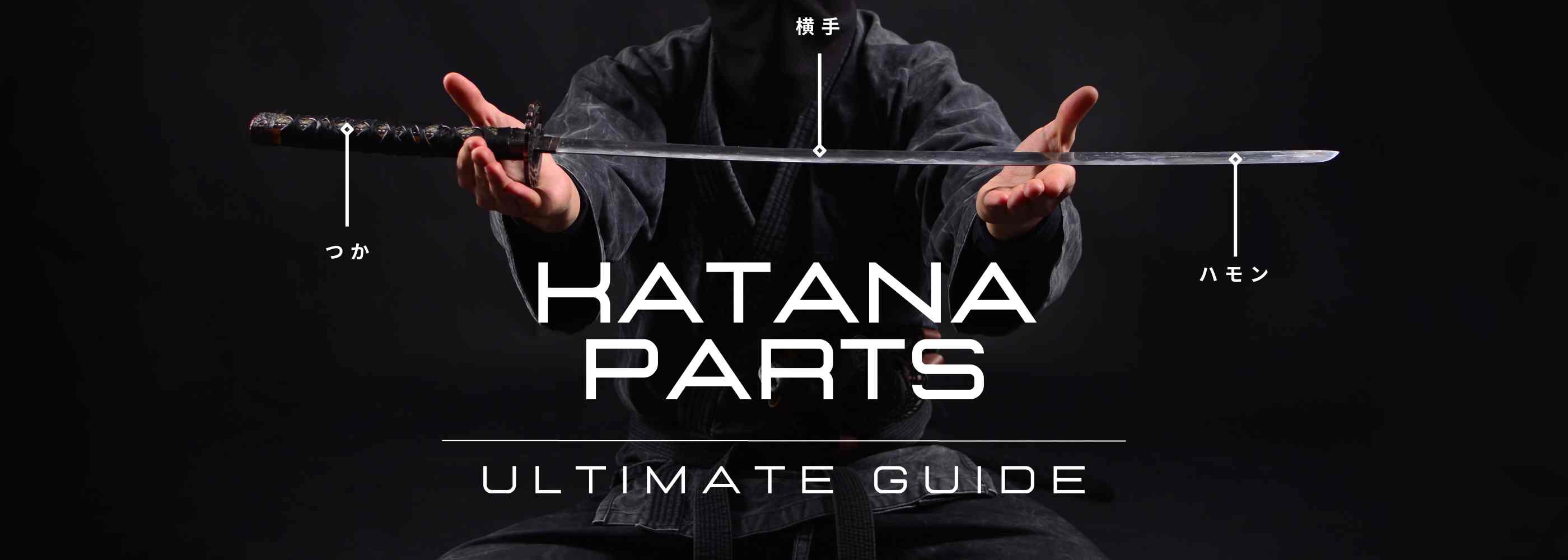Learn more about each unique part and its function, and how together they form the iconic weapon revered worldwide. With this ultimate katana parts guide, you'll appreciate why the katana remains one of the most respected weapons in history. This blog post will give you with vital insights into the anatomy of a katana, diving into each part and its role in the overall construction.
Understanding the purpose and craftsmanship behind each katana part will enable you to appreciate the sword's true beauty and historical importance. So, let's dive into the fascinating realm of katana parts and unravel the secrets behind these extraordinary weapons.
Parts of a katana

1. Katana blade

Nagasa

Katana nagasa refers to the length of a katana's blade. The word "nagasa" can also be used to refer to the overall length of a katana, including the hilt and scabbard. Nagasa is typically measured in shaku, with one shaku equal to about 11.81" (30 centimeters).
Sori

Katana sori refers to the curve of a katana blade. It is an important aspect of the sword's design, and affects the way the weapon is used. You can calculate the sori by adding the length of your blade (nagasa) and the perpendicular line that makes the gap between the farthest point of the curve of the katana and the nagasa (see above).
Shinogi & Shinogi-ji

Shinogi is a Japanese term for "
This ridge line is created by hammering out a groove in the metal and then folding the metal over itself. This results in a stronger sword that is less likely to break during battle.
The shinogi gives the blade strength and durability, and also helps to deflect enemy attacks. In addition, the shinogi provides a place for the sword's maker to sign their name.
Hamon

The katana hamon is a type of sword-smithing technique used to create the distinctive patterns seen on Japanese swords. The hamon, "edge pattern", refers to the line that runs along the blade just above the cutting edge. This line is created by differential hardening, a process in which the body of the blade is heated and quenched in order to create a hard, sharp cutting edge, while the back of the blade is left unhardened. The resulting two-toned blade is then carefully etched to bring out the hamon.
Boshi

The katana boshi is the hamon temper line that extends to the kissaki (sword tip) that is commonly found on Japanese swords. They are characterized by their sharp, tapered point and their long, curved blade. Katana boshi are typically made of high-carbon steel, which gives them their distinctive hardness and strength. Because of their sharpness and strength, katana boshi are often used for thrusting attacks, rather than cutting.
Yokote

The Yokote (横手) is the point line which make the transition between the body of the blade and the kissaki or tip section. Yokote is not present in every blade style, such as the uncommon shobu zukuri style blade, whose tip is more suited to slicing than thrusting.
Kissaki

The kissaki (切先) of a katana is the pointed tip of the blade.It is the blade's sharpest point and is utilized for thrusting and cutting.
The name "kissaki" refers to the general contour of the blade tip, which might be rounded or squared off. The kissaki itself is usually quite small, but the overall shape can vary greatly.
Ha

The katana "Ha" (刃) is the cutting edge. Due to differential hardening, this portion of the blade will be substantially stiffer and harder than the remainder of the blade.
Bohi

The bohi (literally "sword groove") is a distinctive feature found on many Japanese swords. The bohi denotes one or several grooves meticulously carved into the sword blade, stretching from its base up to the tip. The bohi improves the sword's balance, reduce its weight while also improving its visual appeal.
Nakago

The katana tang, or nakago, is the section of the blade that extends into the handle. In other words, the nakago is the portion of the katana tang that protrudes from the handle's base.
2. Katana handle
Habaki

Positioned at the base of the blade, adjacent to the hilt, resides a small but crucial component known as the habaki. This metallic fixture serves the dual purpose of ensuring a snug fit of the sword within its scabbard and creating a secure seal to prevent the ingress of moisture or dirt.
The habaki's composition is typically brass, although it could be crafted from other metals such as copper or steel. It is not just a functional piece, but also a canvas for intricate artistic designs, underlining its significance in the overall anatomy of the sword. The habaki can also be known as the “throat guard”' or “sword collar”.
Seppa

Seppa is a small metal disc traditionally used to secure the katana's hilt onto the saya (scabbard). Seppa could be made from a variety of materials, including brass, copper, bronze, iron, or steel. In addition to their functional purpose, seppa also served as decorative elements, and were often engraved with elaborate designs.
Tsuba

A tsuba (鍔) is a handguard fitted to a Japanese sword. Originally, the purpose of tsuba was to safeguard the hand wielding the sword. However, over time, they have evolved to serve a more decorative function. Numerous distinct styles of tsuba exist, each characterized by its unique aesthetic. Among the most admired designs are the dragon tsuba, the phoenix tsuba, and the tiger tsuba.
Fuchi

The fuchi of a katana is a small, ornamental component affixed to the sword's hilt, or tsuka. It serves a dual purpose, offering protection to the katana's grip while also enhancing the weapon's aesthetic appeal with additional embellishments.
Traditionally crafted from metals such as brass or copper, the fuchi often bears intricate designs, whether through meticulous carvings, engravings, or inlaid patterns.
Playing a crucial role in the composition of a katana, the fuchi is much more than a decorative piece. By safeguarding the grip and contributing additional heft to the hilt, it ensures the creation of a balanced, effective weapon, thus harmonizing both form and function.
Tsuka ito

Tsuka ito is a traditional Japanese cord used to wrap the handle of a sword.
Traditionally, a piece of cloth or leather is utilized for this process, skillfully coiled around the handle and secured with a knot. The practice, known as Tsukamaki or handle wrapping, plays a pivotal role in sword creation. It enhances the sword's grip, providing better control, while simultaneously augmenting its visual allure.
Samegawa

Samegawa, also called "Same" or "Samehada" is the Japanese word for "shark skin". It is a popular material used in making katana handle, due to its durability and resistance to wear and tear.
Mekugi

Mekugi are small wooden or bone pins used to secure the handle scales (tsuka) of a katana in place. The katana's blade (tachi) is also inserted through the Mekugi, which passes through a hole in the tang (nakago). There can be one or more Mekugi in a katana, depending on the sword's design.
Menuki

Menuki are small decorations that were traditionally used to adorn the handle of a sword. Menuki are usually made from metal, but can also be made from other materials such as wood, ivory, or bone.
Kashira

The kashira, a small, circular pommel, is strategically positioned at the handle's extremity, providing equilibrium to the sword. It isn't merely functional, but also ornamental, with numerous kashiras featuring elaborate engravings ranging from flora to fauna motifs.
3. Katana scabbard
Saya katana

The saya, a traditional Japanese scabbard, is customarily employed to house and safeguard a katana. Crafted from diverse materials such as wood, buffalo horn, and lacquer, sayas serve as a protective sheath for the revered Japanese blade. In the Japanese language, "saya" translates to "scabbard". The saya katana was typically worn with the edge facing up, so that it could be drawn quickly in a fight.
Sageo

A sageo is a cord used to secure a Japanese sword (katana) to the waist. It is typically made of silk or cotton and is about 3 feet long. The sageo is passed through the second hole (himo) in the scabbard (saya), and then tied around the obi (belt). The sageo serves two purposes: it secures the sword to the waist so that it will not be lost, and it prevents the scabbard from rattling.
The sageo is also used to secure the sword in the scabbard when carrying it over the shoulder (muna-dori). In this case, the sageo is passed through the himo and then around the neck.
When not in use, the sageo is often wrapped around the hilt of the sword (tsuka), or tucked into the obi.
Kurikata

The kurikata, or kurigata, is a small knob attached to the scabbard (also known as the saya) of a Japanese sword. Kurikata were usually made of metal, and sometimes had decorative features such as carving or inlays. The kurikata on a katana is typically located about midway down the length of the scabbard, near the sageo.
Kojiri

The kojiri (鐺) is a fitting that forms the end cap or protective tip on the scabbard (saya) of a traditional Japanese sword. This piece serves both functional and decorative purposes. Functionally, it protects the scabbard's end from damage and wear over time as it might be dragged or bumped against surfaces.



